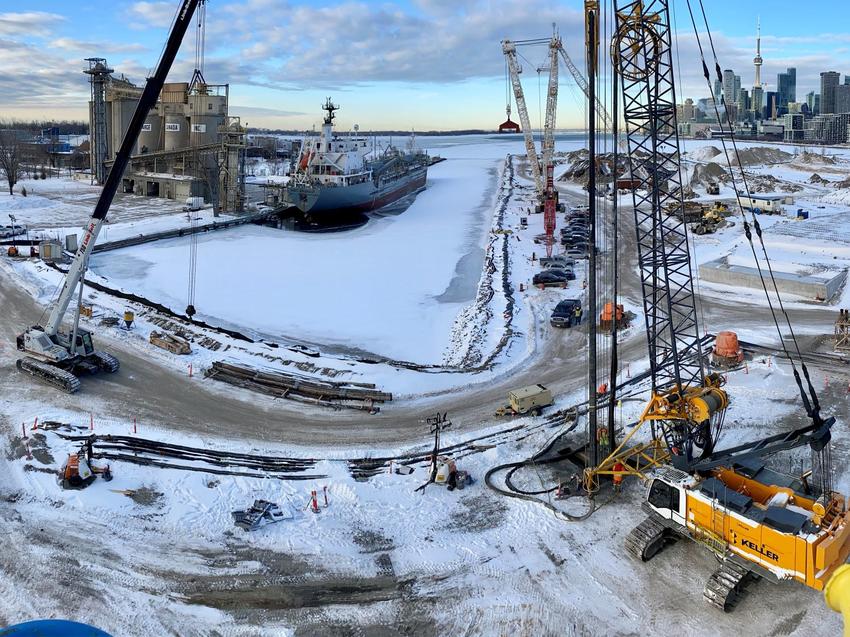The potential of the Port Lands waterfront has long been unrealised and under threat from flooding. But now an ambitious redevelopment is underway, with Keller bringing its expertise in diaphragm walls to help launch a new downtown neighbourhood.

This article was adapted from a feature originally published in Piling Canada.
Located at the mouth of the Don River, Toronto’s Port Lands is one of the largest underdeveloped stretches of downtown waterfront in North America – long considered undevelopable due to its vulnerability to flooding.
Over the last decade, the city has been working closely with conservation authorities and other parties to find a way to develop the area, generating new economic opportunities, while also protecting Toronto from flood damage.
The result of this collaboration is the ambitious, $1.25 billion Port Lands Flood Protection and Enabling Infrastructure project (PLFPEI), which first broke ground in November 2018.
Welcome to Villiers Island
PLFPEI aims to completely transform 290 hectares of underdeveloped industrial zone into a new, vibrant and resilient downtown neighbourhood called Villiers Island. An independent economic impact study in 2016 estimated the project will generate around 51,900 full-time years of employment, $5.1 billion for the Canadian economy, and $1.9 billion in revenues for the government.
The project will also provide critical flood protection by creating a naturalised mouth for the Don River, which will be surrounded by new parks, green spaces and public amenities, in addition to new wetlands that can better support native species.
Keller joined the project in December 2020 and has completed phase one: constructing a diaphragm wall. This technique involves excavating a series of narrow trenches to create large panels reinforced with rebar, concrete and bentonite slurry. Keller opted for a diaphragm wall over secant piles because of significant advantages including fewer construction joints, a stiffer wall with less overall deflection, and lower costs.
Creating a water cut-off
“The diaphragm wall was designed to provide a temporary dam and support the excavation of the new west mouth of the Don Valley River into Lake Ontario, as well as create a permanent water cut-off for the new river channel,” says Richard Males, Field Technician at Keller North America. “This innovative solution offered a reduction in the overall construction schedule and exceptional cost savings for the client.”
The diaphragm wall was constructed using several different panel designs. These were supported by bentonite slurry, allowing Keller to excavate the trenches at depths of up to 44m with less than 0.5 percent vertical deviation at the tip of the panel.
A large-scale de-sanding and mixing process was at the heart of Keller’s operations – producing, recycling and redistributing the bentonite to the excavation site. It was also critical in maintaining a slurry head within the guide wall – and specifically above the water table – to prevent the panels collapsing during excavation.
The highest levels of quality and safety
When the excavation of the panels was complete, large prefabricated reinforced rebar cages, each weighing up to 50,000lbs, were lowered into the trenches. Tremie tubes were then installed through the cages to pump in concrete. This process was repeated for each panel.
During the project the team faced a number of challenges, including cold winter weather, contaminated soil conditions, managing large volumes of concrete and – of course – working through the COVID-19 pandemic. However, Keller was able to demonstrate why it’s the premier geotechnical contractor and complete this major project successfully.
“Keller continuously seeks to provide the highest levels of safety, quality and efficient production for our clients, and this work demonstrated just that,” says Richard. “This project will act as a stepping stone for the continued growth of the unique and advantageous diaphragm wall technology within the Toronto market and beyond.”
The next phase of PLFPEI will start this year and, once complete, other contractors will continue the excavation of the Don River towards Lake Ontario. The entire project is expected to wrap up in late 2023 / early 2024.